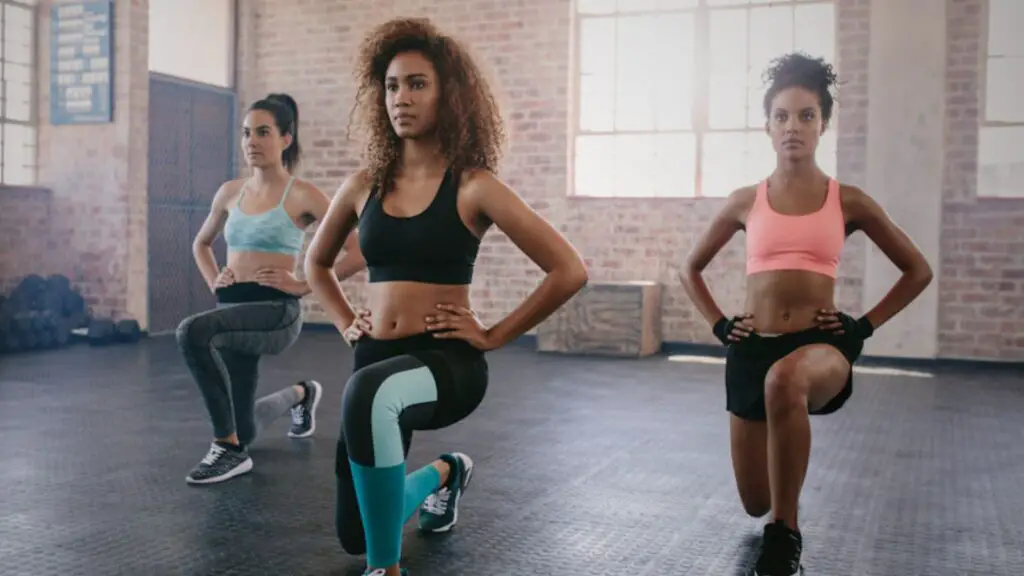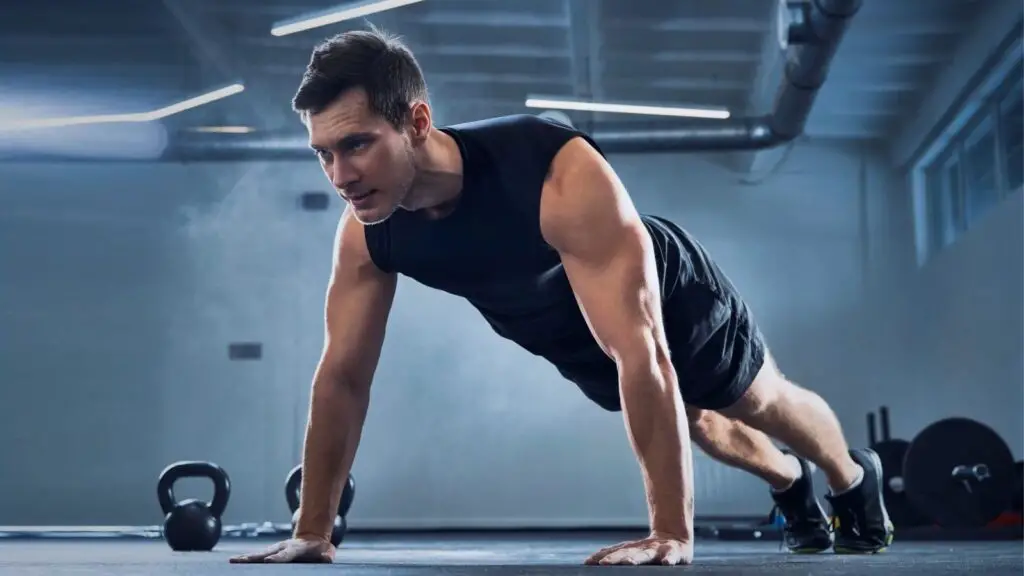You want a bigger back, but you don’t know where to start?
Well, pull ups and lat pulldowns are a great way to get started. Fairly easy to do and highly effective in working the back muscles.
In this article we compare Pull Ups vs Lat Pulldowns, showing you the benefits of each exercise and how to include them in your workout routine.
What are the similarities?
Pull-ups and lat pulldowns are both exercises that target the muscles of the upper back, particularly the latissimus dorsi, which are large muscles that extend from the upper arm to the spine.
Here are some similarities between pull-ups and lat pulldowns:
- Target Muscles: Both exercises primarily target the latissimus dorsi, which is responsible for the wide, V-shaped appearance of the upper back.
- Compound Movements: Pull-ups and lat pulldowns are compound exercises that involve movement at multiple joints. They engage not only the lats but also other muscles, including the biceps, rhomboids, and rear deltoids.
- Vertical Pulling Motion: They both involve a vertical pulling motion. The arms move downward from an overhead position to pull the body or the weight towards the upper chest or behind the neck.
- Grip Variations: Pull-ups and lat pulldowns can be performed with various grip variations, affecting the emphasis on different muscles. Common grips include overhand (pronated), underhand (supinated), and neutral (palms facing each other).
- Engagement of Stabilizer Muscles: Both exercises require the engagement of stabilizer muscles in the shoulders, core, and arms to control the movement and maintain proper form.
- Scapular Retraction: Proper form in both pull-ups and lat pulldowns involves scapular retraction, where the shoulder blades are pulled back and down. This maximizes activation of the lat muscles.
- Variability in Hand Position: The width and hand positioning can be adjusted in both pull-ups and lat pulldowns. A wider grip tends to emphasize the outer portions of the lats, while a narrower grip may engage the inner portions.
- Versatility: Both exercises are versatile and can be adapted to different fitness levels by adjusting the resistance (weight) or using bodyweight only.
- Effective for Back Development: Pull-ups and lat pulldowns are effective for developing strength and size in the upper back, contributing to overall back aesthetics.
- Assistance Options: There are options for assistance or modifications when it comes to doing both exercises. Pull-ups can be assisted with bands or a machine, while lat pulldowns can be adjusted for different strength levels.
While there are similarities, it’s important to note that pull-ups are a bodyweight exercise, requiring you to lift your entire body, while lat pulldowns involve lifting a selected weight stack.
Individuals with different fitness levels or access to equipment may choose one exercise over the other, but incorporating both into a comprehensive back training program can provide a well-rounded approach.
What are the differences?
Pull-ups and lat pulldowns differ in several aspects, from the execution to the way they target the back muscles.
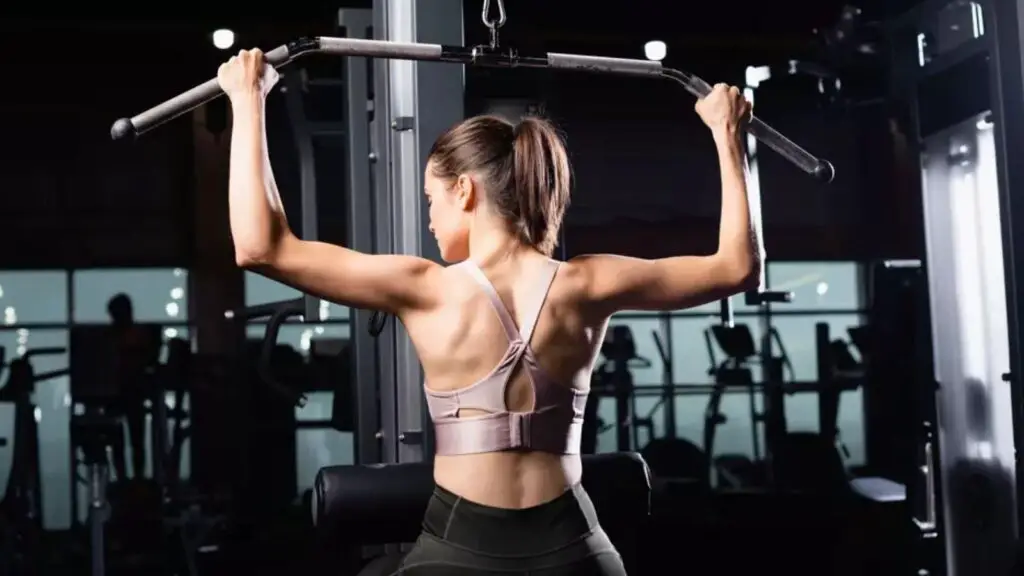
Here are the main differences between the two exercises:
Exercise Type
- Pull-ups: Pull-ups are a bodyweight exercise where you lift your entire body weight by pulling yourself up to a bar. The movement is vertical, and you are lifting your body against gravity.
- Lat Pulldowns: Lat pulldowns involve pulling a selected weight down toward your upper chest using a cable machine. It’s a machine-based exercise where the resistance is provided by the weight stack.
Equipment Needed
- Pull-ups: Typically require a pull-up bar or a sturdy overhead bar. No additional equipment is necessary.
- Lat Pulldowns: Require access to a cable machine with an attached lat pulldown bar or handles.
Resistance Control
- Pull-ups: Resistance is provided by your body weight, making it a challenging exercise that requires strength relative to your body size.
- Lat Pulldowns: The resistance is adjustable by selecting a specific weight on the machine. This allows for easier customization based on strength levels.
Difficulty Level
- Pull-ups: Generally considered a more challenging exercise, especially for beginners or individuals with limited upper body strength.
- Lat Pulldowns: Can be adjusted to different difficulty levels, making it more accessible for individuals of varying fitness levels.
Muscle Engagement
- Pull-ups: Engage various muscles, including the latissimus dorsi, rhomboids, biceps, and forearms. It’s a compound movement that requires stabilization from the core.
- Lat Pulldowns: Primarily target the latissimus dorsi but may not engage stabilizer muscles to the same extent as pull-ups.
Variations in Grip
- Pull-ups: Offer various grip options, such as overhand (pronated), underhand (supinated), or neutral grip. Each grip variation places emphasis on different muscle groups.
- Lat Pulldowns: Also offer grip variations, but the range may be limited compared to pull-ups.
Range of Motion
- Pull-ups: Allow for a natural and full range of motion, requiring the body to move from a hanging position to chin above the bar.
- Lat Pulldowns: Provide a controlled range of motion, and the bar is typically pulled down to the upper chest or behind the neck.
Functional Component
- Pull-ups: Mimic natural pulling movements and are often considered more functionally relevant to daily activities.
- Lat Pulldowns: Are effective for isolating the lat muscles but may be considered less functional in terms of real-world movements.
Accessibility
- Pull-ups: Can be performed almost anywhere with an appropriate bar, making them accessible for bodyweight workouts.
- Lat Pulldowns: Require access to a cable machine, limiting their availability to gym settings.
Overall Versatility
- Pull-ups: Are versatile and can be modified for different grip widths and variations (e.g., wide grip, chin-ups).
- Lat Pulldowns: Offer versatility in terms of grip variations and weight selection.
Both exercises have their advantages, and incorporating a combination of pull-ups and lat pulldowns into a well-rounded training program can provide comprehensive upper back development. Individual preferences, fitness levels, and equipment availability may influence the choice between these two exercises.
Target muscle
Pull-ups and lat pulldowns both primarily target the muscles of the upper back, but they do engage other muscles to varying degrees.
Here’s a breakdown of the target muscles for each exercise:
Pull-ups
- Latissimus Dorsi (Lats): The primary muscle worked during pull-ups is the latissimus dorsi, which is the large, fan-shaped muscle in the back responsible for the V-shaped appearance.
- Trapezius (Traps): The upper and middle fibers of the trapezius are engaged during pull-ups, especially during the downward (eccentric) phase when the scapulae are retracted.
- Rhomboids: The rhomboids, located between the shoulder blades, play a role in scapular retraction and stabilization during pull-ups.
- Biceps Brachii: The biceps are synergistically involved as secondary muscles, assisting in elbow flexion during the pulling motion.
- Brachialis: The brachialis, a muscle beneath the biceps, also contributes to elbow flexion during pull-ups.
- Forearms: The muscles of the forearms, including the brachioradialis and forearm flexors, are engaged to maintain grip on the bar.
Lat Pulldowns
- Latissimus Dorsi (Lats): Lat pulldowns are designed to isolate and target the latissimus dorsi. The emphasis is on the widening and development of the upper back.
- Biceps Brachii: While the biceps are involved in a supportive role, their engagement is not as significant as in pull-ups.
- Rhomboids: The rhomboids are engaged during the scapular retraction phase, providing stability to the upper back.
- Trapezius (Traps): The upper fibers of the trapezius are activated during lat pulldowns, particularly during scapular retraction.
- Forearms: Similar to pull-ups, the muscles of the forearms are involved in maintaining a secure grip on the lat pulldown bar.
Additional Muscles Engaged in Both Exercises
- Erector Spinae: The erector spinae muscles of the lower back are engaged to some extent during both pull-ups and lat pulldowns, especially for stabilization.
- Core Muscles: The muscles of the core, including the rectus abdominis and obliques, are engaged to stabilize the torso during the movements.
While both exercises primarily target the lats, the nature of pull-ups being a bodyweight exercise adds an additional level of engagement for various muscle groups, making it a more compound and functional movement.
Incorporating both pull-ups and lat pulldowns into a well-rounded training program can provide comprehensive upper back development.
How to do Pull Ups?
Performing pull-ups requires upper body strength, particularly in the back, arms, and shoulders.
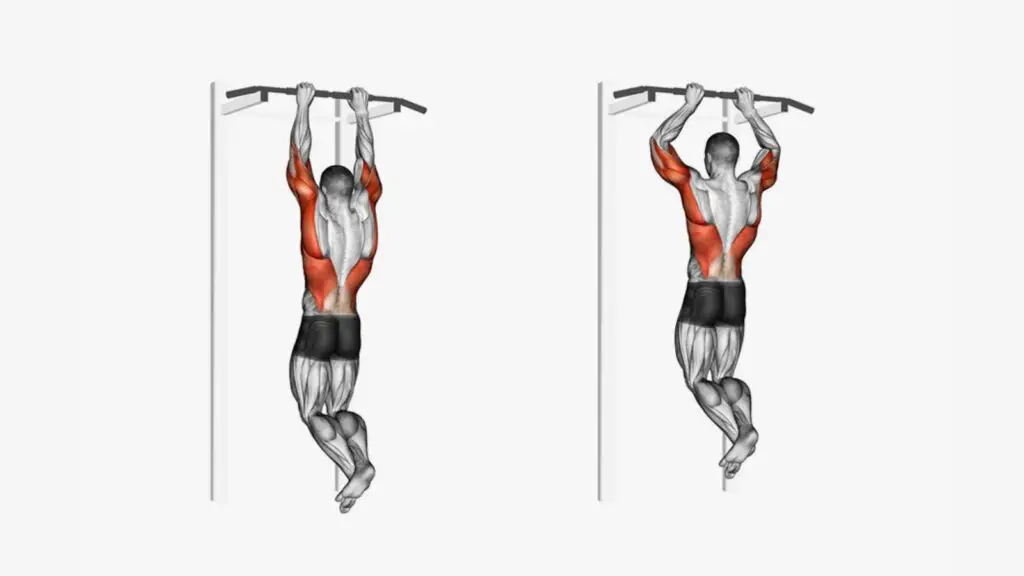
Here’s a step-by-step guide on how to do pull-ups with proper form:
1. Grip the Bar
- Stand beneath a pull-up bar, reach up, and grip the bar with your hands shoulder-width apart.
- Your palms should face away from you (pronated grip).
2. Hang from the Bar:
- Hang from the bar with your arms fully extended.
- Your body should be straight, and your feet should not touch the ground.
3. Scapular Retraction
- Before initiating the pull, retract your shoulder blades by pulling them down and back.
- This engages the back muscles and sets the shoulders in a stable position.
4. Initiate the Pull
- Begin pulling yourself up by bending your elbows and pulling your chest toward the bar.
- Focus on using your back muscles rather than just your arms.
5. Keep Your Body Straight
- Maintain a straight line from your head to your heels throughout the movement.
- Avoid swinging or using momentum to lift your body.
6. Chin Over the Bar
- Continue pulling until your chin is over the bar.
- This indicates a full range of motion for a standard pull-up.
7. Lower Yourself with Control
- Lower your body down with control, extending your arms fully before starting the next repetition.
- Avoid simply dropping down, do it slowly.
8. Repeat
- Perform the desired number of repetitions.
- If you’re a beginner, start with a manageable number of reps and gradually increase as you build strength.
Tips:
- Focus on engaging your back muscles, especially the lats.
- Avoid using excessive momentum or swinging to complete the pull-up.
- Keep your elbows close to your body during the pull.
- If you’re unable to do a full pull-up initially, you can start with assisted pull-ups using resistance bands or a pull-up machine.
- Gradually increase the difficulty by progressing to unassisted pull-ups and experimenting with different grip variations (wide grip, narrow grip, chin-ups).
Variations:
- Chin-ups: Palms facing you (supinated grip).
- Wide Grip Pull-ups: Hands placed wider than shoulder-width apart.
- Close Grip Pull-ups: Hands placed closer together.
- Mixed Grip Pull-ups: One palm facing away, one facing you.
Check out Chris Heria’s workout routine to see how you can include pull ups in your own exercise programme.
As with any exercise, it’s essential to maintain proper form to prevent injury. If you’re new to pull-ups or have any concerns, consider seeking guidance from a fitness professional.
Additionally, consistently incorporating pull-ups into your workout routine will help you build strength and improve your performance over time.
When should you do Pull Ups?
The timing of when to do pull-ups can depend on various factors, including your overall workout routine, fitness goals, and personal preferences.
Here are some considerations to help you determine when to incorporate pull-ups into your workout:
- Upper Body Workout Days: Consider including pull-ups on days when you focus on upper body workouts to maximize the engagement of these muscles.
- Back Day: If you follow a split routine where you designate specific days for different muscle groups, pull-ups can be a key exercise on your back day. This allows you to concentrate on exercises that target the entire back.
- Full Body Workouts: Pull-ups are a compound exercise that engages multiple muscle groups. Including them in full-body workouts can provide a comprehensive training stimulus.
- Strength Training: Pull-ups can be incorporated into strength training sessions when you aim to lift heavier weights with lower repetitions. Use pull-ups as one of the primary compound movements during your strength-focused workouts.
- High-Intensity Workouts: If you’re incorporating high-intensity interval training (HIIT) or circuit training into your routine, pull-ups can be part of these sessions. Include them in circuits for an added challenge and cardiovascular benefit.
- Warm-Up or Activation: Consider including pull-ups in your warm-up routine or as an activation exercise before heavier lifting. This helps engage the upper body muscles and prepares your body for the workout ahead.
- Skill Practice: If your goal is to improve your pull-up strength or master different grip variations, you can practice pull-ups as a skill. Dedicate specific sessions to focus on form and gradually increase the number of repetitions.
- End of Workout: Some individuals prefer to do pull-ups at the end of their workout as a finishing exercise. This can be a way to burn out the muscles and ensure you’ve given your best effort.
- Frequency: Depending on your fitness level and recovery capacity, you can perform pull-ups 2-3 times per week. Allow for sufficient rest between sessions to promote recovery.
Remember to prioritize proper form over the number of repetitions. Additionally, listen to your body and adjust the frequency and intensity based on your individual fitness level and goals.
Benefits of Pull Ups
Pull-ups are a highly effective bodyweight exercise that offers numerous benefits for overall fitness and upper body strength.

Here are some key benefits of incorporating pull-ups into your workout routine:
- Upper Back Development: Pull-ups primarily target the muscles of the upper back, including the latissimus dorsi, traps, and rhomboids. This can contribute to a well-defined and developed upper back.
- Strengthens the Latissimus Dorsi: The latissimus dorsi, often referred to as the “lats,” is the broadest muscle of the back. Pull-ups are one of the most effective exercises for targeting and strengthening the lats.
- Improves Grip Strength: Pull-ups require a strong grip to support your body weight. Regular practice of pull-ups can enhance grip strength, which is beneficial for various daily activities and other exercises.
- Functional Movement: The pulling motion in pull-ups mimics natural movements like lifting, carrying, and pulling. This makes pull-ups a functional exercise that translates to real-world activities.
- Boosts Core Stability: To perform pull-ups with proper form, you need to engage your core muscles for stability. This contributes to improved core strength and stability.
- Scapular Retraction: Pull-ups involve scapular retraction, where the shoulder blades are pulled down and back. This movement is essential for shoulder health and contributes to better posture.
- Adaptable for Different Fitness Levels: Pull-ups can be adapted for various fitness levels. Beginners can start with assisted pull-ups or use resistance bands, while advanced individuals can perform weighted pull-ups for added intensity.
- Cardiovascular Conditioning: Incorporating pull-ups into a high-intensity circuit or workout routine can elevate your heart rate, providing cardiovascular benefits along with strength training.
- Enhances Muscle Definition: Regularly performing pull-ups can contribute to improved muscle definition in the upper body, particularly the back, biceps, and shoulders.
Incorporating pull-ups into your workout routine, along with proper nutrition and recovery, can contribute to overall fitness, strength, and a sculpted upper body.
If you’re new to pull-ups, start gradually and focus on maintaining good form to maximize the benefits while minimizing the risk of injury.
Cons of Pull Ups
While pull-ups offer numerous benefits, it’s important to be aware of potential drawbacks or challenges associated with this exercise.
Here are some cons of pull-ups:
- High Level of Difficulty for Beginners: Pull-ups can be challenging, especially for beginners or individuals with limited upper body strength. The initial difficulty may be discouraging for some individuals.
- Risk of Injury with Incorrect Form: Performing pull-ups with improper form, such as using excessive momentum or a swinging motion, can increase the risk of injury, particularly to the shoulders, elbows, or wrists.
- Requires a Pull-Up Bar or Equipment: To perform pull-ups, you need access to a pull-up bar or suitable equipment. This may not be readily available in all environments, limiting the accessibility of the exercise.
- Limited Range of Motion in Some Variations: In certain grip variations, such as chin-ups or pull-ups with a narrow grip, the range of motion may be limited, potentially reducing the effectiveness of the exercise for some muscle groups.
- May Not Be Suitable for Certain Shoulder Conditions: Individuals with pre-existing shoulder conditions or injuries may find pull-ups uncomfortable or exacerbate existing issues.
- Intensity for Overweight Individuals: Overweight individuals may find pull-ups particularly challenging due to the need to lift a higher percentage of their body weight. Alternative exercises or modifications may be necessary.
- Lack of Variety in Grip Positions: While pull-ups can be performed with different grip variations, the overall range of grip positions is limited compared to exercises like lat pulldowns.
- Potential for Overtraining: If pull-ups are performed excessively without adequate rest and recovery, there’s a risk of overtraining, which can lead to fatigue, decreased performance, and an increased risk of injury.
- May Not Isolate Muscles as Effectively: While pull-ups engage multiple muscle groups, they may not isolate specific muscles as effectively as some isolation exercises.
- Difficulty Progressing to Advanced Variations: Progressing to more advanced pull-up variations, such as one-arm pull-ups or muscle-ups, can be challenging and may require specific training techniques and progressions.
Despite these potential drawbacks, many individuals can benefit from incorporating pull-ups into their workout routine.
Beginners can start with assisted variations or resistance bands to build strength gradually. It’s crucial to prioritize proper form, listen to your body, and adjust the intensity based on your fitness level and goals.
How to do Lat Pulldowns?
Lat pulldowns are an effective exercise for targeting the muscles of the upper back, especially the latissimus dorsi.
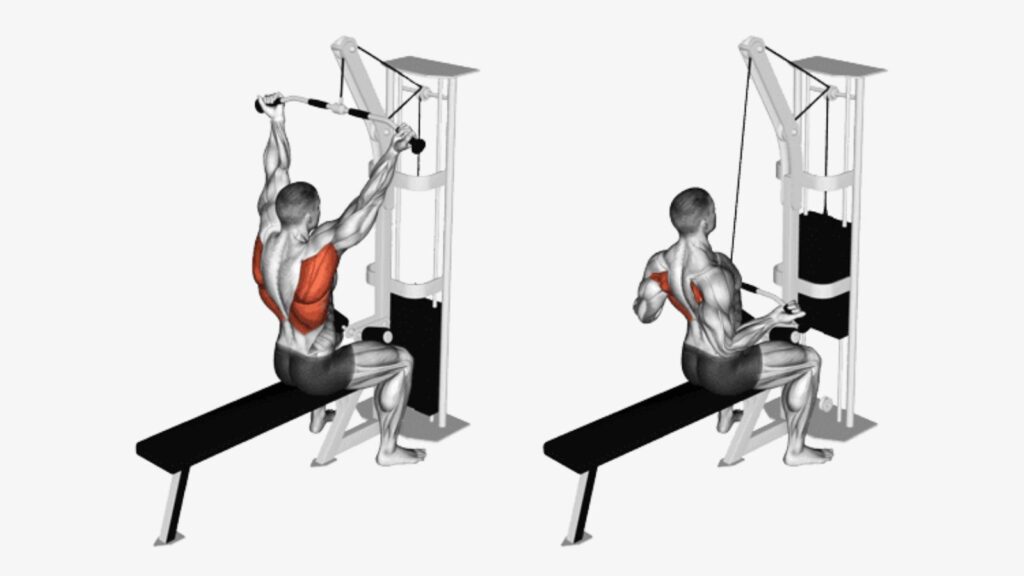
Here’s a step-by-step guide on how to perform lat pulldowns with proper form:
1. Adjust the Machine
- Sit on the lat pulldown machine and adjust the knee pad so that it comfortably secures your legs.
- Ensure that your feet are flat on the ground.
2. Select the Weight
- Choose an appropriate weight for your fitness level.
- If you’re new to lat pulldowns, start with a lighter weight and gradually increase as needed.
3. Grip the Bar
- Reach up and grasp the lat pulldown bar with an overhand grip (palms facing away from you).
- Your hands should be slightly wider than shoulder-width apart.
- Alternatively, you can use different handles for variations in grip.
4. Sit Down with Straight Posture
- Sit down on the bench with a straight back and chest up.
- Adjust the seat or knee pad if necessary to ensure a comfortable and stable position.
5. Engage Your Core
- Before starting the movement, engage your core muscles to stabilize your torso.
6. Initiate the Pull
- Pull the bar down in front of you by first depressing your shoulder blades and then pulling the bar down to your upper chest or behind your neck, depending on your preference.
- The movement should be controlled and deliberate.
7. Elbows In and Down
- Keep your elbows pointed down and slightly inward as you pull the bar towards your chest.
- This emphasizes the engagement of the lats.
8. Squeeze the Back Muscles
- At the bottom of the movement, squeeze your back muscles to fully engage the lats.
- Focus on bringing your shoulder blades together.
9. Controlled Release
- Slowly and with control, allow the bar to rise back up to the starting position.
- Resist the urge to let the weight stack slam back up.
10. Repeat
- Perform the desired number of repetitions.
- Aim for a controlled and smooth motion throughout the exercise.
Tips:
- Avoid using momentum or leaning back excessively. Keep your torso stable throughout the movement.
- If your machine allows for it, experiment with different grip variations (wide grip, narrow grip) to target different areas of the back.
- Adjust the weight as needed to maintain proper form and control.
Variations:
- Reverse Grip Lat Pulldown: Perform the exercise with a supinated grip (palms facing you) to emphasize the biceps and lower lats.
- Single-Arm Lat Pulldown: Focus on one side at a time to address muscle imbalances.
- Behind-the-Neck Lat Pulldown: If comfortable and within your range of motion, perform the pulldown behind your neck.
Incorporate lat pulldowns into your upper body workout routine to strengthen and sculpt your upper back muscles.
Try to prioritize proper form and start with a weight that allows you to maintain control and perform the movement with good technique.
When should you do Lat Pulldowns?
The timing of when to incorporate lat pulldowns into your workout routine can depend on various factors, including your overall training program, fitness goals, and personal preferences.
Here are some considerations to help you determine when to do lat pulldowns:
- Back or Upper Body Training Days: Consider including lat pulldowns on days dedicated to back or upper body training to emphasize the muscles of the upper back, especially the latissimus dorsi.
- Split Routine: If you follow a split routine, where you focus on specific muscle groups on different days, lat pulldowns can be included on your designated back day. This allows you to concentrate on exercises that target the back muscles.
- Pulling Emphasis Days: Lat pulldowns can be included on days when you want to emphasize pulling movements. This can complement other pulling exercises such as rows and pull-ups.
- Full Body Workouts: If you follow a full-body workout routine, lat pulldowns can be integrated as part of a comprehensive upper body workout. This ensures that you engage multiple muscle groups during the session.
- Strength Training Sessions: Lat pulldowns can be incorporated into strength training sessions, especially if your goal is to lift heavier weights with lower repetitions. This allows you to challenge your back muscles with sufficient resistance.
- Warm-Up or Activation: Lat pulldowns can be used as part of your warm-up routine or as an activation exercise before heavier lifting. Performing lat pulldowns with lighter weights can help activate the muscles and prepare your body for more intense exercises.
- High-Intensity Workouts: If you incorporate high-intensity interval training (HIIT) or circuit training into your routine, lat pulldowns can be included in these sessions. They provide a challenging cardiovascular and strength-training component.
- Frequency: Depending on your training program and recovery capacity, you can perform lat pulldowns 1-3 times per week. Ensure adequate rest between sessions to allow for muscle recovery.
Remember that individual preferences, training goals, and the structure of your workout routine play significant roles in determining when to incorporate lat pulldowns.
If you have specific concerns or health conditions, consult with a fitness professional or healthcare provider for personalized guidance.
Benefits of Lat Pulldowns
Incorporating lat pulldowns into your workout routine offers a range of benefits, especially for the upper back.

Her are some benefits you get from performing the exercise:
- Targeted Muscle Engagement: Lat pulldowns primarily target the latissimus dorsi, the large, V-shaped muscle in the back. This helps build width and thickness in the upper back.
- Improved Back Strength: Regularly performing lat pulldowns contributes to increased strength in the upper back muscles, including the lats, traps, and rhomboids.
- Scapular Retraction: The exercise involves scapular retraction, promoting better posture and shoulder health. It reinforces the muscles responsible for pulling the shoulder blades down and back.
- Enhanced Grip Strength: Lat pulldowns require a strong grip to pull the bar down. This can contribute to improved grip strength, which is beneficial for various daily activities and other exercises.
- Versatility in Grip Variations: The exercise can be performed with different grip variations, such as wide grip, narrow grip, or reverse grip. Each grip variation targets the muscles slightly differently, providing versatility in training.
- Balanced Muscle Development: By targeting the upper back muscles, lat pulldowns help create a balanced and proportionate physique. This is especially important for overall aesthetics and functional strength.
- Assistance in Pull-Up Progression: Lat pulldowns can be used to build strength and endurance in the muscles involved in pull-ups. This can be beneficial for individuals working toward achieving their first pull-up or increasing the number of repetitions.
- Safe and Controlled Movement: Lat pulldowns offer a controlled and guided movement, making them suitable for individuals who may find pull-ups challenging or have difficulty with bodyweight exercises.
- Accessibility: Lat pulldown machines are commonly available in gyms, making the exercise accessible for individuals with different fitness levels. This accessibility is particularly beneficial for beginners.
- Isolation of the Lats: Lat pulldowns allow for the isolation of the latissimus dorsi muscles, providing a focused and targeted workout for these muscles.
- Adaptability for Different Fitness Levels: Lat pulldowns can be adapted for different fitness levels by adjusting the weight, making them suitable for both beginners and advanced individuals.
Incorporating lat pulldowns into your workout routine, alongside other back exercises, contributes to a well-rounded and effective upper body training program.
You can gradually increase intensity, as you progress with the exercise, helping to prevent injury and optimize the benefits.
Cons of Lat Pulldowns
While lat pulldowns offer numerous benefits, there are potential drawbacks or cons associated with this exercise. It’s important to be aware of these factors and address them to minimize the risk of injury and optimize your training.
Here are some cons of lat pulldowns:
- Machine Dependency: Lat pulldowns are typically performed on a cable machine, and this equipment may not be readily available in all workout settings. If the machine is not available, it can limit your ability to perform the exercise.
- Limited Range of Motion: Some individuals may find that the range of motion in lat pulldowns is limited compared to pull-ups. The fixed path of the bar may not allow for the same natural movement as bodyweight exercises.
- Lack of Core Engagement: Unlike pull-ups, lat pulldowns do not engage the core to the same extent. Pull-ups require stabilizing the entire body, whereas lat pulldowns involve sitting, which may lead to less core activation.
- Potential for Incorrect Form: Using improper form during lat pulldowns, such as leaning back excessively, can lead to ineffective muscle engagement and potential strain on the lower back.
- Risk of Overtraining: Overusing the lat pulldown machine without sufficient variety in your workout routine can lead to overtraining of specific muscle groups and potential imbalances.
- Not as Functional as Bodyweight Exercises: While lat pulldowns are effective for targeting specific muscles, they may not replicate the functional movements required in everyday activities as closely as bodyweight exercises like pull-ups.
- May Not Fully Engage the Lower Traps: Lat pulldowns may not fully engage the lower trapezius muscles, which are important for overall shoulder health and stability.
To address these cons, it’s important to incorporate a variety of exercises into your training routine, including both machine-based and bodyweight exercises.
Additionally, focusing on proper form, avoiding excessive weights, and incorporating other compound movements can help mitigate potential drawbacks associated with lat pulldowns.
FAQs
Do Lat Pulldowns help you to do more Pull Ups?
Yes, incorporating Lat Pulldowns into your workout routine can be an effective way to build strength in the muscles involved in pull-ups, which may, in turn, help you perform more pull-ups.
It’s important to note that while Lat Pulldowns can be a valuable addition to your training, practicing pull-ups regularly is also crucial for improving pull-up performance.
Is it better to include both exercises in your workout routine?
Doing both Lat Pulldowns and pull-ups into your workout routine can be a well-rounded approach to developing upper back strength and overall back muscularity.
Each exercise offers unique benefits, together providing a more comprehensive stimulus for your back muscles.
How to get better at Pull Ups?
Improving your pull-up performance requires a combination of strength, technique, and consistency.
Focus on strengthening the muscles involved in pull-ups, including the latissimus dorsi, rhomboids, traps, and biceps. Exercises such as Lat Pulldowns, rows, and bicep curls can be beneficial.
Ensure proper form during pull-ups. Start from a dead hang, engage your scapula (shoulder blades) before pulling, and aim to bring your chest to the bar. Avoid excessive swinging or using momentum.
Perform pull-ups through a full range of motion, starting from a dead hang and pulling until your chest reaches the bar. This ensures you engage the targeted muscles fully.
Progress in pull-ups takes time. Be patient and stay consistent with your training.

